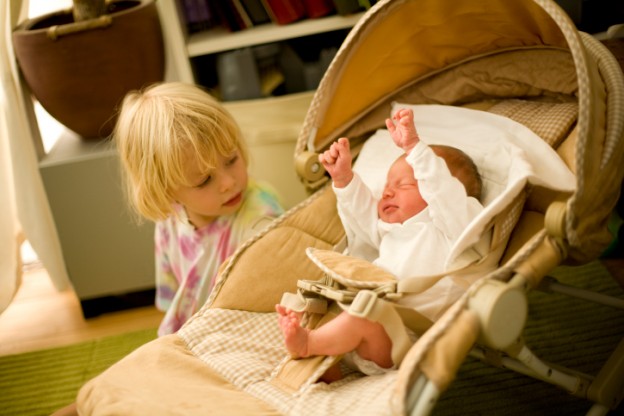
Parenting 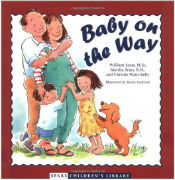 “Baby on the Way” by William Sears, MD, Martha Sears, RN, and Christie Watts Kelly was the best book for helping my son visualize his baby brother. The book has both scientific information about the developing baby and a simple storyline about how the family changes. The follow-up book, “What Baby Needs,” is written specifically for older siblings who are struggling with mixed emotions.
“Baby on the Way” by William Sears, MD, Martha Sears, RN, and Christie Watts Kelly was the best book for helping my son visualize his baby brother. The book has both scientific information about the developing baby and a simple storyline about how the family changes. The follow-up book, “What Baby Needs,” is written specifically for older siblings who are struggling with mixed emotions.
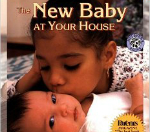 “The New Baby at Your House” by Joanna Cole is filled with photographs of infants with their siblings. The book helps to prepare children for the ups and downs of having a new baby in the house. My son responds better to photographs rather than cartoons or drawings, so this was great for him.
“The New Baby at Your House” by Joanna Cole is filled with photographs of infants with their siblings. The book helps to prepare children for the ups and downs of having a new baby in the house. My son responds better to photographs rather than cartoons or drawings, so this was great for him.
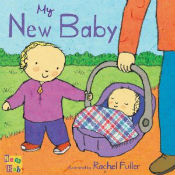 Rachel Fuller has a series of four board books, “Waiting for Baby,” “My New Baby,” “You and Me,” and “Look at Me!” These books are intended for toddlers and preschoolers with simple illustrations and one or two sentences on each page told from the toddler’s point of view. Each book explores a different stage in the sibling relationship.
Rachel Fuller has a series of four board books, “Waiting for Baby,” “My New Baby,” “You and Me,” and “Look at Me!” These books are intended for toddlers and preschoolers with simple illustrations and one or two sentences on each page told from the toddler’s point of view. Each book explores a different stage in the sibling relationship.
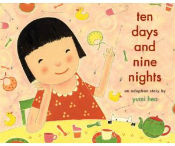 “Ten Days and Nine Nights” by Yumi Heo and “How I Became a Big Brother” by Dave Moore both tell the story of an international adoption from the older sibling’s point of view. Both books address the joyful anticipation and anxiety that children experience.
“Ten Days and Nine Nights” by Yumi Heo and “How I Became a Big Brother” by Dave Moore both tell the story of an international adoption from the older sibling’s point of view. Both books address the joyful anticipation and anxiety that children experience.
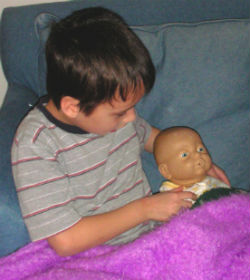 We ordered a life-size, anatomically correct newborn doll - the type used for childbirth education classes - so that our son would get used to the size and appearance of a newborn baby.
We dressed the doll in preemie-size pajamas and newborn-size diaper. Our son named the doll Thomas and carried it everywhere with him. After his brother was born, Thomas’ diaper was changed every time the baby’s diaper was changed. When I carried my baby in a sling, my older son carried Thomas in a sling made from an old scarf or pushed him in a stroller.
We ordered a life-size, anatomically correct newborn doll - the type used for childbirth education classes - so that our son would get used to the size and appearance of a newborn baby.
We dressed the doll in preemie-size pajamas and newborn-size diaper. Our son named the doll Thomas and carried it everywhere with him. After his brother was born, Thomas’ diaper was changed every time the baby’s diaper was changed. When I carried my baby in a sling, my older son carried Thomas in a sling made from an old scarf or pushed him in a stroller.
How To Prepare Your Special Needs Child For The New Baby
Albert Einstein was two and a half years old when he saw his baby sister Maja for the first time. He immediately asked, “Yes, but where does it have its small wheels?”
He had been told that he would be able to play with the baby, and he fully expected this new toy to come equipped with wheels. When parents prepare a child for the arrival of a new sibling, it’s hard to know exactly what the child understands and expects. When the older child has special needs, it may be even more difficult to communicate the changes in the family. My older son, who has autism and learning challenges, was five and a half when his brother was born. My husband and I knew that it would be a sensitive adjustment, but we found many ways to make it easier for our older son - in fact, approaching the subject from several angles was the key to comprehension and compassion.Here are eight ways to prepare your child for a new baby
1. Terminology
The first thing that my husband and I agreed on was that we would use scientifically correct terms to discuss my pregnancy and the baby. Our son associated the words “belly” and “tummy” with eating, and we did not want to confuse him - so we always told him that the baby was growing in my uterus. When he asked how the baby would come out, I explained that when the baby was ready to be born, I would use my muscles to push the baby out.2. Family photos
Most children can’t interpret ultrasound photos, but family photos are a great way to demonstrate how a family’s love grows with the addition of more children. I showed my son his baby photos as well as my own.3. Visit other babies
My son had friends and classmates with younger siblings, so he knew what a baby is and that babies need special attention. I also pointed out babies to him whenever we were shopping - even crying babies - and I would explain what the baby was doing or why the baby was crying.4. Books
 “Baby on the Way” by William Sears, MD, Martha Sears, RN, and Christie Watts Kelly was the best book for helping my son visualize his baby brother. The book has both scientific information about the developing baby and a simple storyline about how the family changes. The follow-up book, “What Baby Needs,” is written specifically for older siblings who are struggling with mixed emotions.
“Baby on the Way” by William Sears, MD, Martha Sears, RN, and Christie Watts Kelly was the best book for helping my son visualize his baby brother. The book has both scientific information about the developing baby and a simple storyline about how the family changes. The follow-up book, “What Baby Needs,” is written specifically for older siblings who are struggling with mixed emotions.
 “The New Baby at Your House” by Joanna Cole is filled with photographs of infants with their siblings. The book helps to prepare children for the ups and downs of having a new baby in the house. My son responds better to photographs rather than cartoons or drawings, so this was great for him.
“The New Baby at Your House” by Joanna Cole is filled with photographs of infants with their siblings. The book helps to prepare children for the ups and downs of having a new baby in the house. My son responds better to photographs rather than cartoons or drawings, so this was great for him.
 Rachel Fuller has a series of four board books, “Waiting for Baby,” “My New Baby,” “You and Me,” and “Look at Me!” These books are intended for toddlers and preschoolers with simple illustrations and one or two sentences on each page told from the toddler’s point of view. Each book explores a different stage in the sibling relationship.
Rachel Fuller has a series of four board books, “Waiting for Baby,” “My New Baby,” “You and Me,” and “Look at Me!” These books are intended for toddlers and preschoolers with simple illustrations and one or two sentences on each page told from the toddler’s point of view. Each book explores a different stage in the sibling relationship.
 “Ten Days and Nine Nights” by Yumi Heo and “How I Became a Big Brother” by Dave Moore both tell the story of an international adoption from the older sibling’s point of view. Both books address the joyful anticipation and anxiety that children experience.
“Ten Days and Nine Nights” by Yumi Heo and “How I Became a Big Brother” by Dave Moore both tell the story of an international adoption from the older sibling’s point of view. Both books address the joyful anticipation and anxiety that children experience.
5. TV Shows
When I needed to put my feet up and rest for a short time, I would watch episodes of Caillou with my son. Caillou’s younger sister Rosie often becomes fussy just like a real toddler, and she is often in her parents’ arms. This was an eye-opener for my son. I liked the episodes because each story was presented as a social story with a new life skill. Dora the Explorer’s mother had a twin homebirth on one episode. Dora talks excitedly about her important job as a big sister, and her enthusiasm is infectious for other big brothers and sisters. Arthur is often conflicted about his feelings for his younger sister, but he always comes to the conclusion that he enjoys being her big brother!6. A “baby” of his own
 We ordered a life-size, anatomically correct newborn doll - the type used for childbirth education classes - so that our son would get used to the size and appearance of a newborn baby.
We dressed the doll in preemie-size pajamas and newborn-size diaper. Our son named the doll Thomas and carried it everywhere with him. After his brother was born, Thomas’ diaper was changed every time the baby’s diaper was changed. When I carried my baby in a sling, my older son carried Thomas in a sling made from an old scarf or pushed him in a stroller.
We ordered a life-size, anatomically correct newborn doll - the type used for childbirth education classes - so that our son would get used to the size and appearance of a newborn baby.
We dressed the doll in preemie-size pajamas and newborn-size diaper. Our son named the doll Thomas and carried it everywhere with him. After his brother was born, Thomas’ diaper was changed every time the baby’s diaper was changed. When I carried my baby in a sling, my older son carried Thomas in a sling made from an old scarf or pushed him in a stroller.



